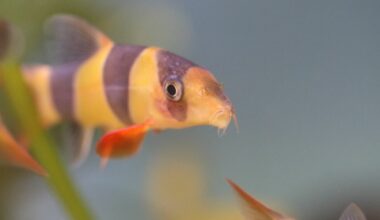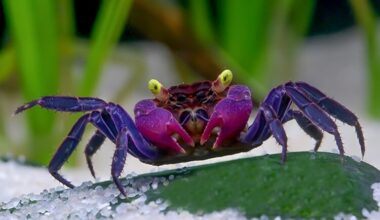Cabomba plants are an excellent option for any aquarist who’s looking to introduce some vegetation into their tank. But unfortunately, many people don’t know the right way to care for them!
This guide will teach you everything you need to know about Cabomba care.
Table of Contents
Species Summary
Also known as fanwort, Cabomba (Cabomba aquatica) is a beautiful plant that can create a stunningly dense underwater forest. These plants are relatively delicate and have a few complex care requirements. But that hasn’t stopped this aquatic plant species from being a favorite among seasoned aquarists.
The plant is ideal for tanks that house shrimp and gentle fish species. It makes the perfect hiding place, creating a safe haven for skittish fish prone to stress. Its presence in any aquarium is breathtaking, and it can do a lot to improve a contained ecosystem.
The Benefits Of Having It In Your Tank
Cabomba serves many purposes. Like other aquatic plants, this cultivar can do wonders to improve water conditions.
It uses up many of the nasty byproducts that fish produce. Instead of allowing the nitrates and ammonia to ruin water quality, the plants can use them to grow and flourish. It also helps with oxygenation, creating a healthier environment for your fish and shrimp.
From an aesthetic standpoint, Cabomba is a beauty. These plants create a dramatic backdrop, allowing you to forgo cheap plastic decor for something more faithful to the wild. Of course, it’s not just about looks.
Fish actively use this plant for shelter and comfort. It’s dense enough to provide adequate coverage, but the leaves are soft and delicate, enriching the lives of the fish that swim through it.
Appearance
This plant species is predominantly used as a background plant. You can grow it as a floating plant, but most aquarists use the dense nature of the leaves to create a natural setting.
The stems are the thickest part of the plant. Comparatively, the branches are fragile. However, they provide enough structure for the plant to move and sway with light water flow.
Along the length of the stem, whorls of wispy branches create an eye-catching plumage. The leaves are needle-like but flexible. Many compare it to fine hair, making a soft net for food and debris shrimp love to eat.
Author Note: A few different varieties are available. The most common and easiest to keep healthy is Green Cabomba. However, you can also get these plants in red and purpose.
Size & Growth Rate
In the right conditions, Cabomba plants can be fast-growing. They reach a maximum height of 20 inches. While some plants can continue growing outside the water, that’s not the case with this cultivar. It requires full submersion and regular pruning.
It can grow up to an inch a day in pristine natural conditions! Fortunately, that rarely happens in an aquarium. The Cabomba will have a medium-fast growth rate for most tank setups, requiring pruning every few weeks.
Cabomba Care
Cabomba plants are widespread in the fish-keeping community. With their good looks, it’s not hard to see why. In terms of care difficulty, Cabomba plants provide an excellent middle ground.
They have unique challenges, but those hurdles are easy to overcome with the proper knowledge. Follow these tips and care guidelines, and your Cabomba will flourish!
Tank Size
The great thing about the Cabomba plant is that it’s not super picky about water volume. It can grow well in small tanks, medium-sized aquariums, and even massive ponds. Most expert aquarists recommend that you keep them in a tank that holds at least 10 gallons, but volume is not a major priority.
The thing you should worry about most is water depth. Too shallow of a tank, and these plants will suffer. Vertically oriented aquariums or tanks with at least 10 inches of water depth are ideal.
Water Parameters
This plant appears all over the world. They’re native to southern parts of North America, but they’re relatively adaptable. In places like Australia, they were improperly introduced and now thrive as weeds!
Cabomba is hardy, but they do best in warm water with plenty of nutrients to absorb. Aim for the following parameters when caring for this plant if you want to see the best results.
- Water temperature: 72 to 82 degrees Fahrenheit
- pH levels: 6.8 to 7.5 (aim for neutral)
- Water hardness: 4 to 12 dGH (soft to moderately hard)
Lighting
Lighting is where many aquarists struggle with Cabomba plant care. These plants need a setup that accommodates medium to high light intensity. That doesn’t mean that the tank needs more hours of light exposure. Instead, it indicates that you need more powerful lights than an average setup.
The Cabomba needs around three watts of light per gallon of water. That’s slightly more than the average of one or two watts that a standard overhead light requires.
Light exposure is critical for Cabomba plants. If the light isn’t intense enough, you may notice discoloration, dying leaves, and other common issues.
Substrate
The best type of substrate to use for the Cabomba is specially formulated aquatic plant soil. One of the first mistakes that inexperienced aquarists make is planting the Cabomba in standard gravel. The roots are far too delicate for loose stone, resulting in a quick death.
A dense plant substrate is best. It can keep the roots anchored down without damaging them. Plus, the nutrients of the soil will help the plant establish itself.
How To Plant It
Cabomba usually comes in bundles measuring around six inches long. Most stores sell them tied together with rubber bands. When you bring the plants home, carefully cut the band and shake the stems loose in aquarium water.
Be extra gentle when handling these plants. The roots are delicate, and they can easily break apart. If you notice any damaged or rotting roots, cut them off. You can safely trim half an inch of the plant without killing it. Cutting lets the plant have a fresh start and develop new roots.
After carefully separating stems, the best way to plant the Cabomba is to anchor the roots about an inch deep into the substrate. For spacing, place them at least an inch apart along the rear of the tank. This spacing allows for ample growth and light swaying without overcrowding.
In the right conditions, fertilizer isn’t necessary. However, a bit of liquid fertilizer can speed up the establishment process. You can also use root tabs and CO2 supplements to help the plant flourish quickly.
Another option is to let the cut stems float in the water. Cabomba does well as a floating plant. It stays close to the surface, harnessing more of the light to proliferate.
Trimming & Pruning
With its medium-fast growth rate, regular trimming is important. In the wild, this plant will grow up to the water line before dropping leaves and propagating new plants. That’s not likely to occur in an aquarium, but the plant could suffer if part of it sticks up beyond the water’s surface.
Invest in a good pair of aquatic plant trimmers. When necessary, gut the stem to keep the plant fully submerged.
Be very careful when pruning. Shaky hands and too much pressure could tug on the plant, leading to root issues. You also want to avoid cracking, shedding too many leaves, etc.
Tank Mates
This plant can create a breathtaking underwater forest for fish and invertebrates to enjoy. But because Cabomba is a fragile plant, you can’t use it in environments with rough fish. Known diggers and uprooters are a big no-no.
Generally, the best rule of thumb is to avoid any fish species that are too aggressive. That includes most cichlids, plecos, and goldfish. They’re too rough for the Cabomba.
It’s also best to steer clear of fish and inverts that enjoy eating plants.
The best tank mates for this plant include peace-loving fish and shrimp. Freshwater shrimp particularly love Cabomba because it collects food remnants they can quickly source.
Good tank mates for the Cabomba include:
- Neon tetras
- Guppies
- Cherry barbs
- Rasboras
- Cory catfish
- Otocinclus
- Cherry red shrimp
- Amano shrimp
- Bamboo shrimp
- Ghost shrimp
- Nerite snails
- Trapdoor snails
Propagation
In the wild, the Cabomba plant can flower. However, that rarely happens in enclosed habitats.
The best way to propagate this plant is to use cuttings. Two to three inches long cuttings can turn into a brand-new plant.
The cuttings need plenty of light and nutrient-rich substrate to grow roots. Anchor them gently into plant soil; they should grow in no time.
Conclusion
Cabomba care isn’t hard once you get familiar with this aquatic plant. It can bring a number of great benefits to your tank, and look great while doing it!
If you have any questions about this plant, let us know. We’re more than happy to give you some additional tips or feedback.

